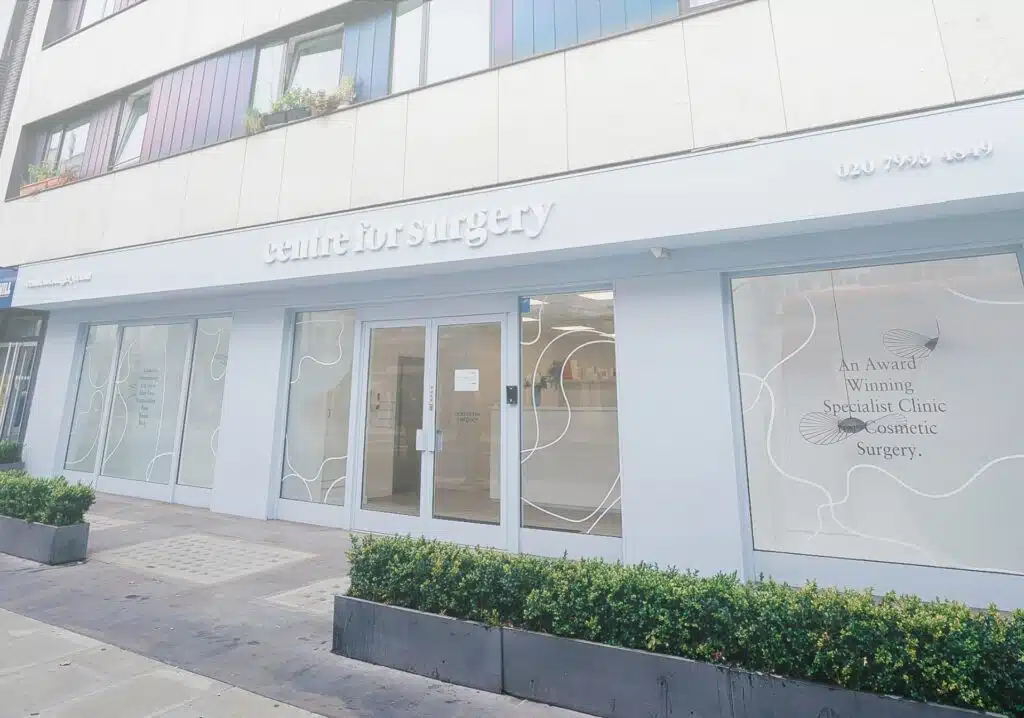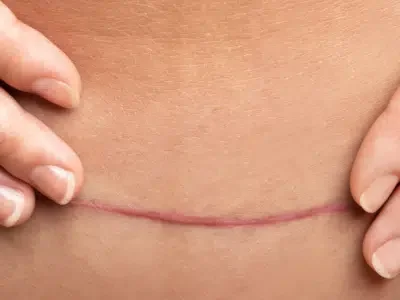Thigh lift surgery is a highly effective plastic surgery procedure for removing excess, saggy and loose skin affecting the thighs after significant weight loss. Centre for Surgery is a specialist plastic surgery clinic in London and is a centre of excellence for post weight loss and excess skin removal surgery. Here, we answer your most commonly asked questions about all aspects of thigh reduction surgery.
Can you tighten loose skin on your thighs with surgery?
Yes, loose skin on the inner thighs can be tightened with surgical procedures such as a thigh lift or liposuction.
How much excess skin can a thigh lift remove?
A thigh lift can remove a significant amount of excess skin in the inner thighs. The exact amount of skin removed will depend on the individual case and the extent of sagging. A consultation with a plastic surgeon can provide a more accurate assessment.
Do I need a thigh lift or liposuction?
The decision between a thigh lift and liposuction for excess skin removal in the inner thighs depends on various factors such as the amount and location of excess skin, the individual’s skin tone and elasticity, and their overall body contour goals. A consultation with a plastic surgeon can provide a more accurate recommendation after a thorough evaluation.
Does liposuction work on the inner thighs?
Yes, liposuction can be performed on the inner thighs to address excess fat deposits and reduce the volume in that area. Inner thigh liposuction is often recommended for individuals who struggle with issues such as constant chafing and recurrent skin infections in the inner thigh region.
However, it’s worth noting that liposuction, including inner thigh liposuction, may result in some degree of loose or crepey skin. The removal of fat through liposuction can lead to changes in skin texture and elasticity. Your surgeon will discuss these potential outcomes with you during the consultation and provide guidance on managing or improving the appearance of the skin post-surgery, which may include additional procedures or non-surgical treatments.
Will a thigh lift get rid of cellulite?
A thigh lift does not specifically target cellulite. It removes excess skin and tightens underlying tissues in the inner thigh area. Cellulite is a condition caused by the underlying fat deposits and fibrous tissue, which push against the skin and give it a dimpled appearance. Cellulite reduction treatments such as Morpheus8 or laser therapy can be used in combination with a thigh lift for optimal results. A consultation with a plastic surgeon can provide a more accurate recommendation.
RELATED: What is the best treatment to get rid of cellulite?
How do I know if I need a thigh lift, thigh liposuction, or both?
Determining whether you require a thigh lift, thigh liposuction, or a combination of both can be done through a self-assessment of your thighs. Begin by touching and gently pinching the skin of your thighs. Take note of the tissue beneath the skin. Is it soft? If so, it is likely that thigh liposuction may be necessary to address excess fat.
On the other hand, if there is no fat tissue present, try pulling the skin back. Is it firm or does it appear loose and stretchy? If the skin appears stretchy and loose, a thigh lift may be the appropriate procedure to address sagging skin.
In some cases, you may observe both stretchy and loose skin as well as soft deposits beneath it. In such situations, a combination of an upper thigh reduction and thigh liposuction may be recommended to achieve the desired results.
Can you have a tummy tuck and thigh lift at the same time?
Yes, a tummy tuck (abdominoplasty) and thigh lift can be performed at the same time. This is known as a combined procedure and can be an effective way to address excess skin and fat in multiple areas of the body during a single surgical session. However, the feasibility and safety of a combined procedure will depend on various factors, such as the individual’s overall health, the extent of the procedures, and the surgeon’s experience.
Can I have a thigh lift straight after tummy tuck?
Yes, it is possible to have a thigh lift after a tummy tuck. However, it is generally not recommended to combine these two surgeries simultaneously. It is advised to space them apart by at least six months. In some cases, surgeons may even suggest waiting a full year between the two procedures to allow ample time for your body to heal effectively. The timing and recommendations can vary depending on factors such as your surgeon’s preferences, your overall health, and the extent of redundant skin present.
SUITABLE CANDIDATES
Am I suitable for thigh lift surgery?
The suitability for thigh lift surgery depends on several factors, such as:
- Overall health and medical history
- Skin tone and elasticity
- Amount and location of excess skin
- Body contour goals
- Realistic expectations
To determine if you are suitable for thigh lift surgery, it is recommended to have a consultation with a specialist plastic surgeon who can evaluate your individual case and provide a personalised recommendation.
What is the best age for a thigh lift?
The optimal age for a thigh lift or upper thigh reduction procedure is typically 18 years or older. This procedure is suitable for individuals who experience issues such as inner thigh chafing or have concerns about loose or sagging skin on their thighs. It can also be beneficial for patients who have undergone significant weight loss.
HOW TO PREPARE
How do I prepare for a thigh lift?
To adequately prepare for a thigh lift, it is recommended to follow these guidelines:
- Quit smoking: If you are a smoker, it is advisable to quit smoking well in advance of the surgery. Smoking can impair the healing process and increase the risk of complications.
- Avoid alcohol: It is recommended to avoid consuming alcohol for at least a week before the procedure, as it can interfere with the body’s ability to heal and may increase the risk of bleeding.
- Maintain a healthy lifestyle: Focus on adopting a healthy lifestyle by eating a balanced diet and staying hydrated. A nutritious diet can aid in the recovery process and help reduce the likelihood of infection.
- Light physical activity: Engage in light physical activity, such as walking or gentle exercises, to promote better blood circulation. Consult with your surgeon to determine the appropriate level of activity for your specific case.
- Follow pre-surgery instructions: Your surgeon will provide you with specific pre-operative instructions, which may include restrictions on eating or drinking before the surgery. It is important to follow these instructions closely to ensure a safe and successful procedure.
PROCEDURE
Where are the incisions for a thigh lift?
The incisions for a thigh lift are typically located in the groin crease or inner thigh and can extend from the groin to the knee or beyond, depending on the extent of skin excess. The specific incision pattern will be determined by the plastic surgeon based on the individual case and the desired outcome. In some cases, a minimally invasive thigh lift procedure using smaller incisions can be performed.
How much excess skin can a thigh lift remove?
The amount of excess skin that can be removed during a thigh lift procedure can vary depending on individual factors such as the extent of weight loss, the amount of loose skin present, and the specific technique used by the surgeon. In general, a thigh lift can remove a significant amount of excess skin from the thighs.
If thigh liposuction is performed in conjunction with a thigh lift, it can remove additional fat tissue. The amount of fat removed during liposuction can vary, but typically, up to 5 litres of fat (at most) can be removed. Liposuction is specifically designed to target and remove localised fat deposits, helping to further refine the shape and contour of the thighs.
RECOVERY AND AFTERCARE
Is A Thigh Lift Painful?
Thigh lift surgery can be associated with discomfort and pain, which can be managed with pain medication prescribed by the surgeon. The extent of discomfort and pain will depend on the individual’s pain tolerance, the extent of the procedure, and their overall health. Most patients experience some degree of discomfort and tenderness in the treated area during the first few days after the surgery, but this typically improves as the swelling subsides and the tissue begins to heal.
How long does it take to recover from a thigh lift?
Recovery from a thigh lift can take several weeks to several months, depending on the extent of the procedure and the individual’s overall health. Here are some general recovery guidelines:
- Pain and swelling: Pain and swelling are normal after thigh lift surgery and can be managed with pain medication prescribed by the surgeon. The swelling may take several weeks to subside.
- Activity restrictions: Most people can return to light activities after 2 to 3 weeks, but strenuous activities should be avoided for at least 6 to 8 weeks.
- Wearing compression garment: The surgeon may recommend wearing a compression garment to help with swelling and to support the healing tissue.
- Incision care: The incisions should be kept clean and dry, and any signs of infection should be reported to the surgeon immediately.
- Follow-up appointments: The surgeon will schedule follow-up appointments to monitor the healing process and make any necessary adjustments.
RELATED: Recovery After Thigh Lift Surgery – Top Tips
How long does swelling last after a thigh lift?
After a thigh lift procedure, the majority of the swelling typically subsides within the first two weeks of recovery. However, it is common to experience some residual swelling that may persist for up to six weeks post-surgery.
The timing of returning to work may vary depending on an individual’s recovery rate and the nature of their job. In many cases, patients can typically resume work by the end of the second week after the thigh lift. However, this should be discussed with your surgeon to ensure it aligns with your specific healing progress.
Driving can usually be resumed around two weeks after the surgery, but it is essential to follow your surgeon’s guidance regarding when it is safe for you to do so.
While most daily activities can be gradually resumed after approximately six weeks, it is important to listen to your body and not push yourself too quickly. Engaging in heavy lifting and strenuous exercise should be avoided until you receive clearance from your surgeon, which typically occurs after several weeks of recovery.
How do you sleep after a thigh lift?
Sleeping positions can affect the healing process after a thigh lift, and it is important to follow the surgeon’s postoperative instructions. Some general guidelines include the following:
- Elevation: Keep the legs elevated to reduce swelling and help with circulation.
- Sleeping position: Sleep on your back or with a pillow between your legs to keep pressure off the incisions and prevent excessive twisting of the legs.
- Avoid sleeping on the affected side: Sleeping on the side with the incisions can put pressure on the healing tissue and delay the recovery process.
When can I shower after thigh lift surgery?
The timing for when you can shower after thigh lift surgery depends on your surgeon’s instructions and the extent of the procedure. In general, you may be able to shower within 24 to 48 hours after the surgery, but your surgeon may recommend that you wait several days to allow the incisions to begin healing. It is important to follow your surgeon’s instructions carefully, as showering too soon or with water that is too hot can increase the risk of infection and delay healing. Your plastic surgeon can provide more specific information on when you can shower after your thigh lift based on your individual case.
How long after a thigh lift can I exercise?
The length of time before you can exercise after a thigh lift depends on the extent of the procedure, the individual’s overall health, and postoperative care. As a general guideline, most patients can return to light activities after 2 to 3 weeks and resume more strenuous activities, such as exercise, after 6 to 8 weeks. However, it is important to follow your plastic surgeon’s postoperative instructions carefully and to avoid any activities that may cause excessive stress to the healing tissue. Based on your case, your surgeon can provide a more specific timeline for when it is safe to resume exercise.
RISKS AND COMPLICATIONS
What are the risks of a thigh lift?
Thigh lift surgery is a safe and effective procedure when performed by a qualified plastic surgeon, but like any surgery, it does carry certain risks and potential complications. Some common risks associated with thigh lift surgery include:
- Bleeding: Bleeding during or after the surgery can occur, although this is rare.
- Infection: There is a risk of infection, which can be treated with antibiotics.
- Numbness or sensitivity: Numbness or sensitivity in the skin around the incisions is common after surgery but typically improves over time.
- Scarring: Scarring is a normal part of the healing process, but the visibility and extent of scarring will depend on the individual and the extent of the procedure.
- Asymmetry: Uneven skin tightening or asymmetry can occur and may require additional surgery to correct.
- Poor wound healing: The incisions may not heal properly, which can result in poor scarring, or the tissue may break down, requiring additional surgery.
What Are The Scars Like After Thigh Lift?
The scars from a thigh lift are typically located in the groin crease or inner thigh and can extend from the groin to the knee or beyond, depending on the extent of skin excess. The scars will be visible and can be red, raised, and tender initially, but they will typically fade over time and become less noticeable. The length and location of the incisions will determine the visibility of the scars and will be discussed with the plastic surgeon during the consultation. In some cases, minimally invasive thigh lift procedures with smaller incisions can be performed, resulting in less visible scars. Good postoperative care and sun protection can help minimise scarring and promote healing. Your plastic surgeon can provide more information on what to expect with scars following a thigh lift.
How do I minimise scars after the thigh lift surgery?
Minimising scars after thigh lift surgery requires a combination of proper surgical technique and good postoperative care. Here are some steps you can take to minimise scars:
- Follow your surgeon’s instructions: Be sure to follow your surgeon’s postoperative instructions carefully, including the use of topical ointments and dressings, as well as avoiding excessive sun exposure.
- Keep the incisions clean and dry: Keeping the incisions clean and dry can help reduce the risk of infection and promote healing.
- Massage the incisions: Gently massaging the incisions can help improve circulation and minimize scarring.
- Use silicone sheets or gels: Silicone sheets or gels can help reduce scarring by keeping the incisions hydrated and promoting healthy tissue growth.
- Avoid sun exposure: Excessive sun exposure can cause hyperpigmentation and increase the visibility of scars, so be sure to protect your incisions from the sun.
- Wait until incisions are fully healed: Wait until the incisions are fully healed before using any creams or lotions that could cause irritation or discolouration.
- Avoid smoking: Smoking can impair circulation and slow the healing process, so it is important to quit smoking or avoid smoking for several weeks before and after the surgery.
When can I see the final results of the thigh lift surgery?
The final results of a thigh lift surgery may take several months to become apparent as the swelling subsides and the incisions heal. It is common for some swelling and residual swelling to persist for several months, particularly in the first few weeks after the surgery. Over time, the swelling will resolve, and the incisions will fade, revealing the final results. However, it is important to keep in mind that individual results may vary and that maintaining a stable weight and healthy lifestyle can help ensure the longevity of the results. Your plastic surgeon can provide more information on what to expect with the final results of your thigh lift.
Will saggy inner thigh skin come back after a thigh lift?
After a thigh lift, the excess skin that is surgically removed will not come back. The removal of skin during the procedure is permanent. However, it’s important to note that the ageing process and factors such as weight fluctuations can still affect the appearance of your thighs over time.
If you experience significant weight gain or loss after a thigh lift, it may cause new skin stretching and potentially impact the results of the surgery. It’s crucial to maintain a stable and healthy weight to preserve the outcomes of the thigh lift procedure.
Additionally, factors related to age and genetics can contribute to changes in the skin’s elasticity and overall appearance over time. As you age, your skin may naturally lose some of its firmness, which can affect the appearance of your inner thighs.
Is a thigh lift permanent?
A thigh lift procedure can provide long-lasting results, but it’s important to understand that it is not completely permanent. While the skin that is surgically removed during the thigh lift cannot come back, other factors can still affect the appearance of your thighs over time.
As you age, your skin naturally loses some of its elasticity, and this can contribute to new skin sagging in the treated area. Additionally, factors such as fluctuations in weight, lifestyle changes, and genetic factors can impact the long-term results of a thigh lift.
Although the exact duration of the results can vary from person to person, it is generally expected that the visible effects of a thigh lift can last for around 10 years or more. However, it’s important to note that individual experiences may differ based on factors like age, overall health, and genetics.
Thigh Lift Surgery at Centre for Surgery
If you would like to learn more about the benefits of thigh reduction surgery, call us today on 020 7993 4849 or complete the contact form below. Our specialist cosmetic surgery clinic in Marylebone is considered one of the most advanced day surgery facilities in the UK. We carry out hundreds of post-weight loss skin removal procedures each year. Our specialist plastic surgeons are renowned experts in excess skin removal surgery and will work with you closely to plan the most suitable treatment to achieve the best outcomes.
RELATED: How much does a thigh lift cost?










